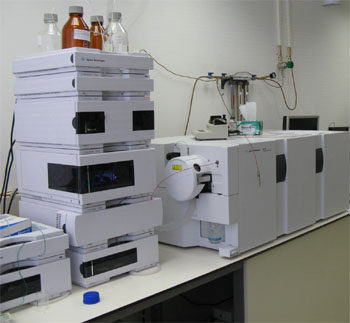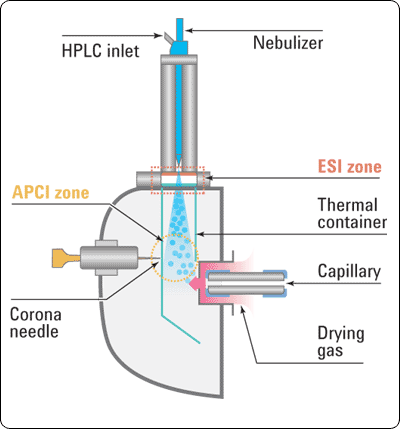The Interdepartmental Equipment Facility
The Triplequad LC/MS
An LC/MS separates mixtures of compounds by High Performance Liquid Chromatography (HPLC), and detects and analyzes the separated compounds, one at a time, by Mass Spectrometry, .
Why Use LCMS?

LC/MS has several advantages over regular HPLC systems:
- 1. Significantly higher sensitivity
- 2. Molecular weight determination
- 3. Information on chemical structure
- 4. Identification of analytes
- 5. Analytes resolved from co-eluting contaminants
- 6. Accurate background-free quantitation
The Agilent 6410 Triple Quadrupole Mass Spectrometer, Paired with Agilent's 1200 Series HPLC, can detect and quantitate reproducibly femtogram levels of target compounds. Triple Quadrupole LC/MS systems are frequently used for quantitative analyses of trace organic compounds in complex matrices. Typical applications include metabolic studies, environmental and food safety analyses, drug development, toxicology and forensics.

The different compounds, separated from the sample mixture on the HPLC column, are sequentially introduced into the electrospray ion source, still under atmospheric pressure. The sample is nebulized and excess solvent is eliminated by counter-flow drying gas. the targeted molecules are ionized and are immediately accelerated into the evacuated mass spectrometer through the sampling capillary.
Passing through a small skimmer aperture the ions are next focused by an octupole ion guide, and by ion lenses, into the first quadrupole mass filter (Q1). The quadrupole consists of four parallel rods to which specific DC and RF voltages are applied. The hyperbolic shape of the rods enhances ion transmission and spectral resolution. These rods filter out all ions except those of one or more particular m/z values (mass/charge ratio) as determined by the voltages applied.
The first quadrupole allows only ions of the selected target mass to pass into the collision cell which is filled with nitrogen. The selected sample molecules strike collision gas molecules generating product ions and some neutral fragments. The product ions generated in the collision cell are now accelerated into the 3rd quadrupole (Q3) for a second filtering stage which enables the user to isolate and examine the different products. For quantitative analysis of target compounds, this mass filter is operated in the selected-ion monitoring mode. Leaving the third quadrupole, the selected ions are accelerated towards the detector, an electron multiplier.
The Agilent 6410 Triple Quadrupole Mass Spectrometer
